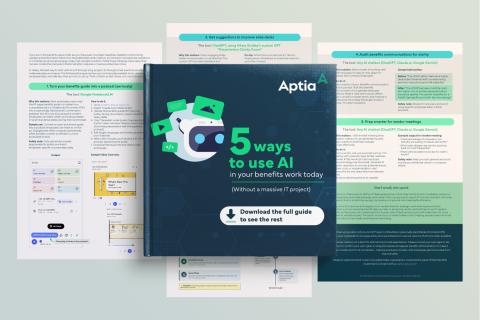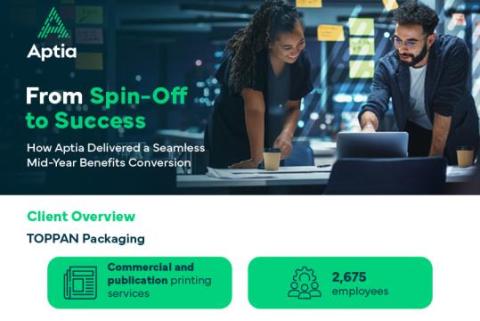What Are Employee Benefit Programs?

Imagine walking into work knowing your health is protected, your future retirement is funded and your family’s well-being is covered. That sense of security is exactly why employee benefit programs have become a cornerstone of the modern workplace. When thoughtfully designed, these offerings elevate employee satisfaction, strengthen loyalty and give organizations a competitive edge in attracting top talent.
At their core, employee benefits are non-salary rewards - ranging from health coverage and paid leave to professional development and commuter benefits. They round out a comprehensive benefits package. Together, these programs answer a fundamental question: What are employee benefit programs delivering beyond a paycheck? The answer is clear: Well-structured benefits meet diverse employee needs, foster engagement and drive long-term employee retention.
Recent data underscores the impact of comprehensive employee benefits. According to MedBen’s 2024 update, 88% of employees rank healthcare as extremely important. Companies that prioritize fair compensation and supplementary benefits are most likely to score highly on lower turnover rates. That’s why more and more employers are investing strategically.
If you’re interested to learn more about how robust offerings improve job satisfaction, boost employee engagement and reduce costly company expenditures, this article features the insights you need to bolster your employee benefits programs this year.
Understanding Employee Benefit Programs and Their Role in the Workplace
Employee benefits fall into two broad categories — mandatory and voluntary. Understanding the distinction is essential for both compliance and strategic planning. Mandatory benefits are those you must provide under federal or state law. They typically include:
- Health insurance
- Social Security and Medicare contributions
- Unemployment insurance
- Workers’ compensation coverage
- Certain paid leave requirements, depending on the jurisdiction
Voluntary benefits, on the other hand, are optional perks you choose to offer to strengthen your overall benefits program and support diverse employee needs. Common examples are:
- Supplemental life insurance
- Accident, critical illness, or hospital indemnity coverage
- Wellness programs and mental health support
- Pet insurance
- Flexible or remote work options and commuter benefits
When you combine these two categories into a single, well-structured benefits plan, the payoff can be substantial. Employees who feel valued by their employers as a result of fair benefits offerings are twice as likely to report strong job satisfaction, which in turn boosts productivity and fosters a positive employee experience.
Yet designing and sustaining effective employee benefit programs is not without hurdles. Budgeting remains a primary concern, with employee benefits taking up a considerable chunk of the total spend on labor costs. The overall message from industry experts and administrative professionals is loud and clear: Every benefit allocation and program addition must deliver clear ROI!
Compliance adds another layer of complexity. Employers must stay current with evolving regulations such as the ACA, FMLA and ERISA, maintain accurate records and communicate program details clearly to every eligible employee. Balancing cost control with comprehensive benefits, all while meeting legal obligations, is the challenge that drives many HR teams to seek specialized support.
Popular Employee Benefit Types
A well-rounded benefits plan covers multiple dimensions of an employee’s life, ensuring support today and security tomorrow. Below are the categories most frequently prioritized by forward-thinking employers.
Family-oriented benefits: Family-focused benefits deliver peace of mind when life events demand extra support. In fact, companies offering robust family benefits report higher employee loyalty and lower absenteeism.
Paid leave: Leave can be a combination of paid and unpaid, essential for parental responsibilities, adoption assistance, subsidized childcare and other caretaker duties. Employees appreciate being able to focus on holistic lifestyle needs without sacrificing career momentum.
Career development benefits: Professional advancement incentives speak directly to ambitious professionals who might value tuition reimbursement, certification programs, mentorship platforms and internal mobility initiatives.
Physical and mental health benefits: These have surged in importance, reflecting a holistic view of employee well-being. These offerings reduce stress, improve productivity and demonstrate a genuine commitment to employee well-being.
Retirement benefits: Financial planning and security beyond the working years are vital, particularly among older working professionals. Matching contributions to a 401(k) shows employees you value their future.
Fringe perks and work-life balance benefits: Additional benefits coverage adds flexibility and personalization to your overall benefits program. Options such as remote or hybrid work arrangements, flexible schedules, commuter benefits, employee discounts and lifestyle stipends create daily convenience and help employees integrate work with personal responsibilities.
From insurance benefits and retirement savings to voluntary benefit options like commuter benefits or employee discounts, it’s important to strike a sensible balance as an employer so that your workforce is well-provided.
Effectively Managing Benefit Programs: Legal and Budgetary Frameworks
Designing a compelling benefits plan is only half the battle. Administering it within legal and financial guardrails is where many HR teams feel the most strain. Your approach must balance compliance, cost control and employee expectations, all while safeguarding sensitive data.
Several factors shape the legal and budgetary framework of every benefits program:
- Company size often sets the baseline: Organizations with 50 or more full-time employees, for example, fall under the Affordable Care Act’s employer mandate, influencing the scope and structure of health benefits.
- Cost considerations can be program-defining: Benefits can represent up to 30% of labor expenses, with each addition needing to demonstrate a clear return on investment.
- Workforce demographics: Various competitive pressures push employers to refine offerings so they address the specific needs of eligible employees while remaining fiscally responsible.
Compliance essentials require a structured lifecycle. A solid roadmap typically covers these fundamental stages:
Stage 1: Planning — Clarify objectives, evaluate employee needs and project costs carefully.
Stage 2: Design — Compare benefit vendors, negotiate rates and build policy documents.
Stage 3: Implementation — Roll out the employee benefit plan, communicate eligibility and train benefits administrators.
Stage 4: Management — Coordinate enrollment, process claims and maintain accurate record-keeping for audits.
Stage 5: Assessment and review — Measure utilization, gather employee feedback and adjust the benefits package to align with emerging trends or changes in legislation.
Throughout each stage, meticulous documentation is non-negotiable. Accurate records protect you during audits, support statutory reporting and ensure every employee, whether full-time or part-time, receives the correct coverage. U.S. employers must also stay alert to statutory obligations such as:
- ACA — Mandates affordable health coverage for large employers and sets reporting requirements.
- FMLA — Guarantees up to 12 weeks of unpaid, job-protected leave for qualified family and medical reasons.
- ERISA — Governs retirement benefits and welfare plans, dictating fiduciary responsibilities and disclosure rules.
- COBRA — Allows eligible employees to continue health benefits after separation.
- HIPAA — Protects personal health information and stipulates data privacy standards.
Integrating these legal frameworks with budgetary discipline often calls for technology-driven solutions. Benefits administration platforms automate eligibility checks, track costs in real time and flag compliance gaps before they become liabilities. By combining smart software with expert guidance, you maintain a comprehensive benefits program that satisfies regulatory demands and keeps your workforce engaged without jeopardizing financial health.
Best Practices: 5 Tips for Successful Employee Benefit Programs
Building a benefits program that resonates with employees while supporting business objectives requires deliberate strategy and continuous refinement. The following best practices help you strike that balance.
Tip #1: Start by anchoring every benefit to your organization’s goals and values. If innovation sits at the heart of your culture, offering education stipends and professional development funds reinforces that narrative. When your mission highlights employee well-being, generous wellness programs, mental health resources and paid leave signal authenticity and strengthen employee loyalty.
Tip #2: Customization is equally critical. A multigenerational workforce rarely shares identical priorities, so analyze workforce demographics, conduct pulse surveys and segment offerings accordingly. Younger employees might prioritize student loan repayment or commuter benefits, while seasoned professionals lean toward retirement savings and disability insurance. Personalized packages drive higher employee engagement because each individual sees tangible relevance in the benefits offered.
Tip #3: Competitive intelligence keeps your benefits plan fresh. Regular benchmarking against industry peers reveals gaps or opportunities. Perhaps competitors have introduced caregiver support, or a rising number of employers now cover fertility treatments. Armed with this insight, you can adjust proactively rather than reactively, ensuring your benefits offering remains a tool for employee retention and attraction.
Tip #4: Technology can make or break benefits administration efficiency. Modern platforms streamline enrollment, surface real-time utilization metrics and simplify compliance reporting, freeing HR leaders to focus on strategic decisions instead of paperwork. Keep an eye on emerging tools such as AI-driven benefits personalization or mobile-first wellness apps to enhance employee experience and monitor ROI with precision.
Tip #5: Never underestimate the power of employee feedback. Encourage ongoing dialogue through quarterly surveys, focus groups or open forums, then close the loop by acting on the insights you gather. When employees see their suggestions shaping the benefits package, trust grows, morale rises and participation in voluntary benefits climbs.
To weave these ideas into a cohesive strategy, consider the following checklist:
- Define clear objectives that link each benefit to business outcomes.
- Analyze employee needs using demographic data, surveys and utilization reports.
- Benchmark offerings against peers and track market trends for emerging benefits.
- Leverage technology for enrollment, data analytics and compliance management.
- Establish feedback loops to review and refine programs regularly.
Following these steps positions your organization to deliver comprehensive benefits that satisfy employees, respect budget constraints and sustain long-term corporate success.
FAQs: Developing Valuable Employee Benefit Programs
Q1: What Are the Top 5 Types of Employee Benefits?
The five categories that employees expect most are health benefits, retirement benefits, paid leave, wellness programs and flexible work arrangements. Together, these options address physical and financial security, work-life balance, personal well-being and job satisfaction. Note: Comprehensive health insurance remains a cornerstone, and many employers now aim for broader coverage by layering on wellness programs, gym stipends, therapy services and mental health days.
Q2: What Is an Example of an Employee Benefit Plan?
A typical employee benefit plan might include a group health insurance policy, a 401(k) with employer match, employee assistance for mental health, short-term disability insurance and paid parental leave. Bundling these offerings under a single benefits plan streamlines administration and ensures every eligible employee receives consistent coverage.
Remember that discretionary perks often become powerful differentiators in competitive talent markets, boosting employee morale and attracting new, talented employees.
Q3: What Benefits Do Employees Value Most? Studies from SHRM and Forbes Advisor show employees prioritize comprehensive health insurance, generous paid time off, retirement savings plans, flexible or remote work options and robust wellness program support. These benefits directly influence employee engagement, loyalty and job satisfaction.
The key is striving to empower employees to sharpen their skills and envision a long-term future with your organization. When you invest in professional development, you signal that growth opportunities don’t stop at onboarding, which fuels employee engagement and retention.
Q4: What Are the Employee Benefit Expenses?
While benefit expenses differ from one company and industry to the next, employers can spend up to 30% of their total labor costs on benefits, with health coverage being the largest line item. Expenses may also include Social Security contributions, workers' compensation, disability insurance premiums, paid leave accruals and the administrative costs of benefits administration platforms.
Design Employee Benefit Programs That Reshape Company Culture
A thoughtful benefits strategy does more than fill a compliance checklist; it actively shapes an environment where talented employees feel valued, protected and inspired to excel. When benefits programs align with organizational values and employees’ real-world needs, they become powerful tools for attracting top talent and providing the job security that today’s workforce demands.
Well-designed benefits programs ripple through every stage of the employee lifecycle. During recruitment, a compelling benefits offering differentiates you from competitors and signals a genuine commitment to employee well-being. Once employees are on board, comprehensive benefits boost morale, deepen engagement and reduce turnover — saving you the significant costs tied to frequent rehiring. Over time, consistent investment in employee experience fosters a culture of loyalty, collaboration and sustained performance, reinforcing your employer brand in the marketplace.
If you’re ready to transform your culture and streamline the complexities of benefits administration, contact Aptia to learn more about streamlining your employee benefits and pension administration.


